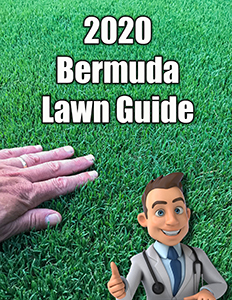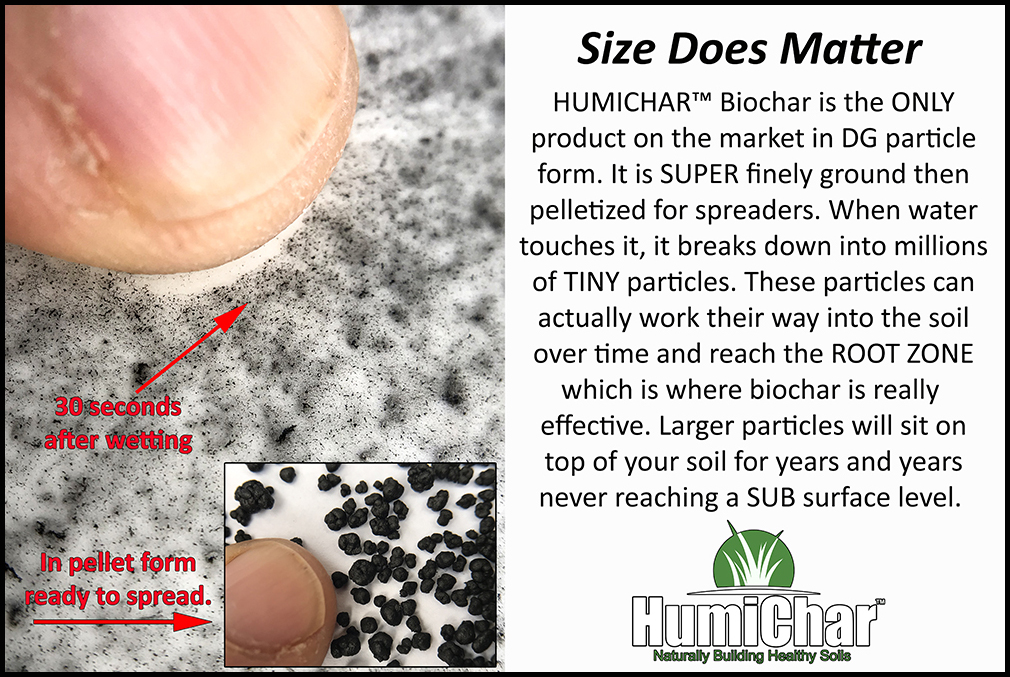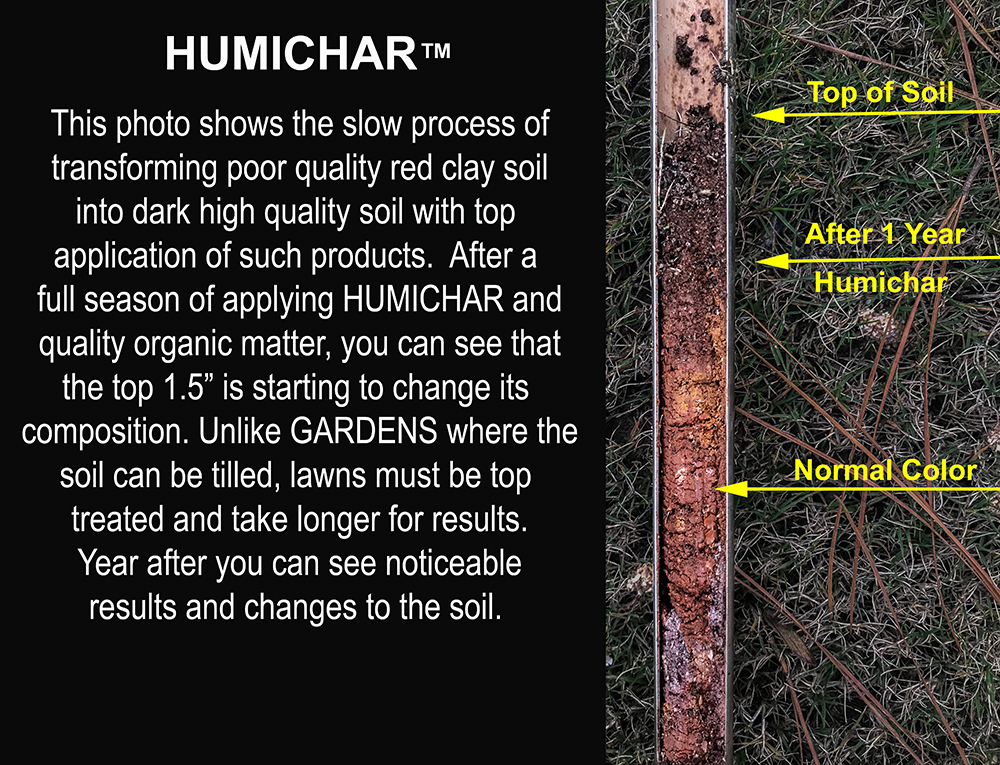Bermuda Lawn Guide
These guides are FREE to use and share. No APP to download, no email signups, nothing. We leave these websites up 365 days a year for use them all you want.
Zoysia Lawn Guide is → HERE
Cool Season Grasses, fescue, KBG, and Rye are located → HERE
Important Notes
STOP – Read First
There are 2 ways to read this guide, below is the full text, and the new EASY READ subject by subject version is located → HERE. You can also adjust the font size and background color for easier reading by clicking the wheelchair icon.
Recommended Products
We have worked for years to help bring YOU, the average homeowner professional grade products that have NOT been available before and NOT found in the average “big box store”. See them → HERE
Anyone Can Transform a Lawn
ANYONE… can have a great Bermuda lawn… even if your lawn is more than 70% weeds. I have transformed some of the worst. (Watch this video) Bermuda is a VERY forgiving grass.
Trust me… it’s not rocket science. It’s more of a “problem / solution” thing, understanding WHAT… to do WHEN… and WHAT to use for best results.
Bermuda grass is a VERY (the most aggressive) spreading grass type in the US. If you learn how to make the plant and your soil healthy it will spread like CRAZY and often in one full season, you can start to see a great looking lawn.
2022 Lawn Care Calendar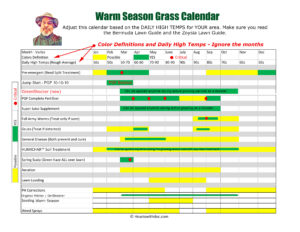
The Jump Start Program
Make sure you read and try the new JUMP START program that will give your lawn the jump start on all your neighbors.
Learn how to use GREEN SHOCKER…
Green Shocker is THE ONLY fertilizer / supplement of its kind on the market today. It goes to work instantly and can be applied to any lawn, anytime during the growing season.
DIY Lawn treatments or Hire a Lawn Service?
The majority of “lawn chemical companies” do 3 things.
- Spray a 30-0-5 fertilizer a few times a year based on their route. (Not lawn’s needs.)
- Spray pre-emergent in the spring, and maybe in the fall.
- Add weed killers and apply to your lawn whether it needs it or not. (Most have ONE tank that treats all the lawns.) Often causing summer burns.
Basically… you’re a number on a route and if you have issues such as grubs, army worms, or fungus, they generally don’t treat for them. Our advice if you want a golf course quality lawn… Drop the lawn company… Period.

They also don’t take WEATHER into consideration when applying products. NOT SMART.
For about the same price of a “service” you can get TWICE the treatments and specifically design a program for your lawn’s needs.
Why are we stressing HUMICHAR?
Every lawn and garden in the world will benefit from HUMICHAR. In simple terms… you are adding a pure form of carbon that will last forever and eventually you will REDUCE the need for so much fertilizer. I STRONGLY ENCOURAGE YOU to watch the videos we have produced and learn why the agriculture industry is now so focused on this product.
The Seasonal Stages of Bermuda Grass

Winter– Your lawn is sleeping and it is dormant. Grass is brown. Remember, while it is dormant, it is still alive. DON’T put down TOTAL KILL products like RoundUp.
Early Spring- Your lawn is starting to wake up, slow growth. Green shoots start to show up and eventually a green haze shows.
Late spring– temps rise into the 80s and the growth starts to accelerate. We start to see “runners” and the Bermuda will spread and thicken.
Early summer– temps touch into the 90s and your grass is starting to SURGE in growth. Bermuda loves the 85-90 degree temps.
Mid summer – As long as it has water, Bermuda will grow and grow.
Fall – Bermuda growth starts to slow but remains green until frost temps hit.
Bermuda Hates Shade… Period

RULE #1… For Bermuda to grow well, it really needs 8 hours of full sun a day. END OF STORY. I’d love to tell you that some varieties do better than others, but honestly… it LOVES the sun and no one has TRULY created a shade tolerant Bermuda.
Again, I said for it to grow WELL.

If you have trees casting shadows on your Bermuda… trim them up VERY high. This is known as lifting the canopy. Keep trimming lower branches and go up HIGH to eliminate as much shade as possible. The next option… cut the tree down. (Sorry)
I have areas that get reduced sunlight and they are ALWAYS weaker. Fertilizer will NOT help the problem. You might see a LITTLE success by allowing shaded areas to grow a little taller, but go back to rule #1… Bermuda hates shade.
Bermuda Seed – Sod – Basics
Hybrid vs. Common Bermuda
Generally speaking… in “Bermuda terms”
Hybrid means laboratory developed / bred and there is no SEED that can be planted to grow the grass. Most SOD is hybrid. Plugs are generally used grow it, it is cut up and sold as sod. Most hybrid is a very fine bladed grass and grows dense. Any seeds produced / grown are sterile.
Common Bermuda is used in fields and lawns. The seeds can be purchased easily and cheaply and the grass has a more “thick” blade and the grass looks course. It’s very cheap seed and does NOT produce a FINE think blade like sod or golf course turf.
The biggest mistake people make is over seeding SOD… grass with cheap COMMON Bermuda seed. You will see a texture and color difference and it will look strange. Even if you use high quality seed you will still be able to see a texture and color variation. Just be aware.
Specialty Seed – On the website we list HIGH QUALITY seed that “replicates” the look and growth patterns of hybrid Bermuda. If you MUST do some seeding, see those links. DO NOT be cheap on the seed. It’s what your lawn will be for years and years. THIS IS A LAST RESORT. 99% of Bermuda lawns can be restored because Bermuda is so aggressive. NOTE: ALL BERMUDA SEED SOLD BY THE LOWES AND HOME DEPOT IS COMMON BERMUDA. Most high quality Bermuda seed runs $7 – $35 a POUND… this seed gives you the fine texture you seek.
YOU CAN… over seed common Bermuda with the HIGH QUALITY seed and let the two battle it out. Keep it cut short and usually the fine blades will win if kept very short.
Time to Seed
The best time to plant new Bermuda grass seed is when daytime temps are in the 80’s. (Late spring / early summer.) This is the “sweet spot” but it also can be planted during the summer months if LOTS of water is available. Do not plant Bermuda seed in the early spring or fall. Use PGF Complete to fertilize the new seed at the bag rate of one bag 18 pound (not 40) per 5000 sq ft. DO NOT use a starter fertilizer. Use PGF Complete.

How to Seed
It’s best to treat the lawn for weeds (no pre-emergent for 3 months prior) at least 2-3 weeks BEFORE seeding and make sure there has been good rain or watering since the treatment. Weed killers MUST be gone first. You must have rain to wash away weed killers.
Heavily rake the area or rent a bladed DETHATCHER / SCARIFIER which will loosen up the soil and thatch. DOC BOUGHT THIS ONE. Bermuda seed likes to be 1/8” to ¼” deep. (Watch the video below)
Spread the seed with a HAND spreader at the rate shown on the bag or heavier.
Water 2-3 times a day lightly until the seed germinates, then once a day for the next 2 weeks. You want to make sure the soil stays moist through the early germination and growth.
Be GENTLE with the new Bermuda the first season. Use no weed killers for the first 2 months, then VERY sparingly the rest of the season. Deal with some weeds and just live with them. The following year we’ll deal with these including pre-emergent.
How Bermuda Grows
Roots – The roots of Bermuda grass can be VERY deep. Some have been recorded as deep as 60 inches. Most established lawns have root systems that run 8 – 16” deep. They are very fine, string like roots.
Runners (rhizomes and stolons) – Here’s the phrase we use. Rhizomes must RISE UP in order to be stolen. Rhizomes are under the ground and stolons are above the ground. Both have NODES which are reproductive points that will grow roots and start a “new plant”.

Rhizomes: a continuously growing horizontal underground stem which puts out lateral shoots and adventitious roots at intervals.
We can actually Steal these runners and plant them in bare areas. So if you have bare spots, let these runners grow on your sidewalk and driveway (don’t edge) steal them, and plant them in bare spots. Video link Below
Bermuda Sod

When to Lay Sod
Tough to say due to construction needs, but it’s best to lay sod during the peak growing season if you have the choice. Early to late spring is my favorite time. Make sure you DON’T apply pre-emergents prior as it will limit new root growth.
A soil test is a good idea if you have the time and a light coat of a PGF 10-10-10 a few weeks before is not a bad idea.
Regardless of whether you’re tilling or not, make sure you apply the new HUMICHAR ®
MAKE SURE to follow the new sod water plan that most companies give you. Something like… water 3 times a day the first week. 2 times a day the second week. Once a day the third week. New sod must be kept slightly moist NOT WET. Just don’t let it dry out.
New sod care
Be gentle with it the first year. Only use light PGF Complete and light Super Juice. Either spot treat weeds or live with them the first year. No pre-emergent for the first 8-12 months. Pre-emergent stops NEW cell production with whatever it contacts. Since it’s in the GROUND… it can slow the growth of new roots. (bad) Deal with some weeds the first year then attack them the second year with good pre-emergent program. People often want to do too much the first year but really just LEAVE IT ALONE and give it water, and a LITTLE food. The SECOND year is when you start the full program.
Seed Heads in my lawn?

Seed heads are quite normal and generally appear late spring through the summer. Most seeds cannot grow FYI, they are sterile. Just keep cutting the lawn and they eventually go away. Just a pain that usually lasts a week or two.
You generally will not see these in short cut Bermuda.
Bermuda Cutting Height
Stop arguing…Bermuda likes to be short…PERIOD

Bermuda grass likes to stay between ¾” and 1.5” for the majority of the growing season. Yes, MANY people let their Bermuda grow to 3 inches or even taller, but this is NOT the ideal length. Again we said the IDEAL length for Bermuda grass, that golf course look, and good health. THE LONGER IT GETS… THE MORE BROWN SCALPING YOU’LL HAVE.
While long lengths might be good for drought conditions, it simply is not a good practice and will promote more issues such as fungus and bugs. (Video below)

Also, the taller Bermuda gets, the more BROWN STALK you will have below the green. As you cut you lawn you will many scalp marks. (Shown in the video below)
Tall Bermuda stocks are 30% green and 70% brown. So when you cut TALL Bermuda you often have scarring show which is different from scalping.
Short Bermuda is better… hands down. If you keep your Bermuda short, it will not have these “brown stalks”. It will be an even green color but require more cutting and water.
How often to Cut
The more the better is the answer. Again, if you want a GOLF COURSE quality lawn, be prepared to get some exercise. During the peak growing seasons… many short lawns need to be cut every 2-3 days. (Golf fairways are cut every 1-2 days) On our backyard golf fairway project this past season we reel cut the lawn to ½” every other day.
Best Lawn Mower for Bermuda

Hands down… without a doubt… after much testing… we love the Mclane Reel Mowers. We have devoted several videos to them and done much testing. Rotary mowers are OK… but you will constantly deal with scalping issues since no one has a flat lawn. My suggestion is to go with the 25” unit as the wide width will help with uneven bumps and ruts. Make sure you order the one we link to as it has the front roller. (The bigger the better the finished cut.)
I own TWO Tru-Cut reel mowers, a 20” and a 27”. They are VERY well made and cut well. However, after switching to the Mclane, I have less maintenance, it’s a lighter unit, and it’s easier on the body to use. I have let 3 people try both and they all agree.
All putting greens and fairways are cut with reel mowers. So if you want a short beautiful lawn, look into a reel mower. However, if you do use a rotary or riding mower, make SURE you have scalp wheels and know how to adjust them. The more scalp wheels the better FYI.
Weight of the mower…
Bermuda, like most plants on earth, does not like heavy weight crushing down on it. It can even be damaged by excess foot traffic. Again, Mclane reel mowers help solve this problem. Large riding mowers can leave rut marks in the lawn / soil. Reel mowers don’t. Make sure you change your cutting PATTERNS as often as possible. Horizontal one cut, vertical the next, then opposite diagonals. Avoid cutting when SOIL is wet and soft. You’ll leave rut marks.
Should I Bag Clippings?
If you are cutting your lawn frequently then always return your clippings. Very few lawns have EXCESS thatch build up and the thatch layer (dead grass on the ground) holds in moisture. Only dethatch your lawn if the thatch layer exceeds ½”. If you have to do a HARD CUT… like you went away on vacation… or grass is very wet… bagging or raking up the excess is a good idea. Otherwise return the clippings.
Piles of excess clippings after a short cut or cut of LONG GRASS should be raked up and removed. These PILES will kill off Bermuda below it and cause fungus issues.
Should I DETHACH Bermuda?
Any type of grass that grows through a system of RUNNERS… should not be dethatched with PRONGS. You will end up pulling up the runners and doing more harm then good. If you have thatch buildup use DirtBooster and the booster spray. Let it work naturally. Golf course and sports turf managers will often VERTICUT or Fraze cut. This is done when you want a very thin turf for sports play and ball roll. (i.e. Soccer Fields) If you NEED to dethatch, then use a BLADED dethatcher like the one below.
Rolling Your Lawn

I generally say NO to rolling since it has little to no impact or visible results. The weight needed to see REAL results takes a rented 1000 lb rolling machine. So the push rollers you can rent or buy do very little other than cause sore bodies. TRUST ME… we have tested time and time again rolling with these type of rollers does very little.
Leveling you lawn…
If you’ll watch the video below AFTER you read this section you’ll understand. Leveling has many forms and SCALES. I try and cover all in the video. But read on….
Leveling your lawn can be a MASSIVE and expensive project depending on just how bad your lawn is and the size of it.
When leveling it’s best to use a LEVELING MIX which is 70% sand and 30% organic matter. But if you can’t find this CLEAN sand can be used.
REMEMBER… golf courses use PURE SAND on greens and fairways because they are built from HEAVY SAND BASED soils. (LAWNS ARE NOT) So using SAND is fine. However PLANTS… don’t grow well in pure sand and it can get VERY hot in direct sun. Therefore a MIX of soil and sand is best on lawns.
Leveling should be done during the growing season. Your hard work can be washed away if you do it during the dormant season.
It often takes several treatments to have a TRULY level lawn.
The lower the grass the better. The lawn should be SCALPED to the ground. Remember you are leveling the ground… not the grass and the grass will get in the way. Hiring a leveling service is great, but will be expensive if they do it right.
But wait…..
I have recently come to a conclusion that may SAVE you both money and time. You may also not be THRILLED with the leveling only result since you are generally only spreading ¼ to ½ inch of leveling sand. (That won’t cure 2-3” ruts)
If you have a large yard with large ruts and bumps all over your lawn, you may be better off spending the money on a REEL MOWER and ROLLING your lawn in the off season. Trying to LEVEL that beast will take truckloads and truckloads of leveling mix.
Rolling in the OFF SEASON will not greatly, negatively impact the lawn and will reduce RUT MARKS and dips. Do this while the soil is moist… not soaking wet. (Dry ground won’t move)
I’ll be doing more testing so watch for the videos.
Best NPK Fertilizer Numbers
N = Nitrogen P= Phosphorus K= Potassium
This is where the FUN begins.
First Rule to follow…. Don’t buy “specialty” fertilizers…
We all hear about STARTER fertilizers, COMBO weed & feed fertilizers, fall fertilizers, new lawn fertilizers, root builders, etc, etc, etc. The simple FACT is that adding an EXCESS of a needed nutrient (more than the plant needs) will NOT produce greater / increased results such as more roots. There are PLENTY of research articles about this and I suggest reading “Gardening Myths”. A great book that explains this in detail. Fertilizers feed the soil, and the plant uptakes what it NEEDS only. If there is plenty of a nutrient already in the soil adding MORE will not help this process and ini fact could cause negative issues.
From that book…
“The idea that we feed the plant what they need seems to make perfect sense but it ignores one very important point. Plants get their food from the soil. You don’t add fertilizer to plants—you add it to soil. This is an extremely important concept that is not well understood and is best explained by a simple example. Assume that your soil is naturally very high in phosphorous. The fertilizer you use at transplant time, or for tulips, or to get more blooms does not need a high amount of phosphorous because your soil already has more than your plants can use. The fertilizer you add to the garden should be a supplement to what is lacking in your soil.”
If your lawn’s soil is deficient in one of the 20+ nutrients it needs to be healthy… apply it. PERIOD… end of story. You now completely understand NPK numbers. (Sort of)
How do you know if your lawn is lacking a nutrient or has excess? A soil test right?
However, more than 99% of the yards in the US will not get a soil test done this year. They will simply apply a fertilizer. Based on THAT fact… what is the best NPK numbers for ALL grasses?
Just about every extension office in the world and expert will tell you that WITHOUT a soil test, a balanced fertilizer with a 4-1-2 ratio should be applied. Yes, many will tell you not to add phosphorous unless it is deficient… BUT DO YOU KNOW THAT FACT? That is why we add a SMALL amount of “P”.
Remember that RATIOS are expandable. So a 16-4-8 like PGF Complete is actually a 4-1-2. (Just divide it by 4)
The ratios are actually PERCENTAGES. Here’s the trick. Pretend every bag you buy is 100 pounds. 100 pounds times 16% is how many pounds of nitrogen? That’s right. 16 pounds. See how easy that was. Now if your bag is really 50 lbs… how many pounds of N do you have? 8… that’s right.
If someone says to apply one pound of N per 1000 sq feet… how many square feet will that bag cover? 8 pounds times 1000 = 8000 sq feet.
WHY PGF COMPLETE?
I can’t stress this enough… PGF Complete was specifically laboratory designed to our specs to be the PERFECT lawn fertilizer. 16-4-8 ratio of Nitrogen, phosphorus, potassium. 3% Iron, micro nutrients and Humic Acid. It has 3 forms of HIGH quality nitrogen. It has TINY particle size which is what ALL golf courses and pro turf managers use for better and more even coverage.
It uses NO bio products, waste product, sewage, or manures.
It is fairly mild. .58 pounds of nitrogen per 1000 sq ft is the standard application rate. (Most fertilizers are one pound) This means we can STACK IT, applying every 3-6 weeks during the PUSH times of our lawns.

Weed and Feed or Mixed Use Products
“Lawn products for dummies”… no offense but that’s the way you need to think of it. It’s one of the largest selling products for a reason. Most people just don’t understand professional lawn care. Avoid COMBO products at all times. Apply only what your lawn needs and use a QUALITY product.
Organic Fertilizers (The good and bad)
Organic fertilizers are made from either WASTE products (poo) or grain products like soybean. We prefer the soy based organics like INNOVA
Don’t get me wrong… I love organics, but they have their limitations. The problem with organic fertilizers is that they are VERY, VERY mild and must be DIGESTED by microbes before they release the nutrients. Why is this BAD? If you have a weak lawn, bare spots on your lawn (dirt) or weak areas, the organics will not really feed that bare soil. A chemical fertilizer like PGF Complete WILL. So when new grass wants to move in there, it finds nutrition. They are fairly expensive for the amount of nutrients applied. If your lawn is weak use a fertilizer like PGF Complete.
They will not PUSH weak lawns to thicken up like PGF Complete will. Directly targeting exact nutrients is the BENEFIT of chemical fertilizers. Organics cannot do this.
The good… they are great for lawns that are thick and healthy during the summer months. They add carbon, amino acids, and cannot burn the lawn. If your lawn is healthy and the summer heat is coming… feel free to use the INNOVA
If your lawn is weak or you want it to thicken up, use a direct chemical fertilizer such as PGF. I now consider my organic treatments as SUPPLEMENTAL FEEDINGS that add organic matter and carbon.
Supplements like GreenShocker ™
GreenShocker is a brand new product for 2022 and it takes time to understand how and when to use it. Basically, 99% of fertilizers are SLOW release fertilizers and you have no control of how they are released. GreenShocker is 100% fast release fertilizer that once watered in, reaches your lawn and roots in hours. Results can be seen in as little as 3 days. Because it’s mild, it can also be used in the summer and on cool season grasses. Watch the video below.
Spray Supplements – Super Juice Supplement
If you’ll ACTUALLY LEARN about spray supplements, you’ll come to love them. If you think they are miracle producers, you’ll be disappointed. Spray supplements have been used for decades by professional turf managers, golf courses, and sports fields. Some of the benefits and their roles are below. SUPER JUICE is Doc’s own formulated mix.
- Granular fertilizers don’t cover 100% of the ground. They are spaced out and don’t reach every blade of grass. Super Juice Supplement reaches every blade of grass.
- Grass often WANTS a little more nutrient in-between granular feedings.
- They are VERY mild, and are great to use during stress periods or during periods when we don’t want to PUSH the growth.
- They are BROAD spectrum feeders, containing ALL the nutrients your lawn needs.
- They contain IRON for the deep green.
- We can mix them with other treatments like fungicides and pest controls.
- You are constantly adding humic and fulvic acid to your lawn increasing the CEC (nutrient hold capacity) of your soil.
Remember this rule… granulars put down the BULK of nutrients and have a very noticeable impact on growth. Spray supplements are very mild and will NOT result in dramatic growth, but much better health.
Super Juice is a DRY POWDER you mix with water and contains EVERYTHING you lawn wants and needs. Apply it every 2-3 weeks all during the growing season.
In the fall we STOP granular feedings at some point. At this point only Super Juice should be used until the first frost.
Soil Treatments
Below is the first EVER… production of HUMICHAR™ and it is a beautiful thing.

Improving your SOIL… is a critical part of a GREAT lawn. There are two main soil treatments on the market today. Humic Acid and BioChar. Both are good for lawns but are a mess to apply.
As soon as water touches these tiny pellets they disburse into 1000’s of tiny particles giving a wonderful even coverage without the hassle and mess. (My wife even thanked me) No more “black foot prints” in the house.

Critical…. Size does matter. Most other LAWN biochars remain on TOP of your soil and never work down into the ROOT zone.
HUMICHAR ™ can be used in ANY soil but is specifically designed for TOP APPLYING on lawns. Normal biochars can NOT enter the soil quickly due to their size and remain on TOP for months and even years. HUMICHAR ™ is ground EXTREMELY fine allowing quicker movement to the ROOT ZONE which is where biochar does most of it’s work. (SEE Size Does Matter PHOTO BELOW)
Both have their benefits so which do you choose? This problem has been solved with the 2020 release of HUMICHAR™ DG
HUMICHAR™ DG is a blend of both humic acid and biochar. This blend is then turned into DG particles. These particles instantly disintegrate into 1000s of sub-particles once water hits them.
HUMICHAR™ DG contains NO NUTRIENTS and can be put down at ANY TIME… and with ANY OTHER product. You cannot put down too much or too often. (We have done EXCESS testing with no negative results)
What does Humic Acid do?
- Improves your soils ability to both HOLD nutrients and RELEASE those nutrients to the lawn. Cation Exchange Capacity (Watch the video on www.HumiChar.com )
- Adds carbon to the soil.
- Improves germination and viability of seeds
- Increases microbial activity in the lawn.
- Helps the plant uptake more nutrients via the roots.
- Improves soil structure for better aeration and water movement
What does BIOCHAR Do?
Adding Biochar (carbon rich charcoal) to soil will improve the quality of soil over time. It has the ability to aid in coping up with the greenhouse gases and is helpful for carbon sequestration. Various evidences and studies showed that the utilization of biochar can be extremely useful for the improvement of Soil organic Carbon, capacity of water holding, stimulating soil microbes, increasing the microbial activity and biomass , decreasing in needs and leaching of fertilizers, availability and retention of nutrients, soil aeration, bettering the growth and yield of crop growth.
The main difference is TIME.
Humic acid works fast… Bio Char works slow, but lasts longer. Combining the two gives the best of both worlds.
Think of HUMICHAR™ this way…
Great soil is made by things dying and rotting on a constant basis. (A variety of organic matter.) This includes both plants and animals. That really doesn’t happen on your lawn. Grass grows… grass is cut. REPEAT. Rake leaves… pick up poo.
Your lawn never has the opportunity to have new carbon and organic matter added which over time makes your soil a poor place to live and grow.
By adding HUMICHAR™ you are giving your soil the things it needs to become a “growing machine” where nutrients are stored and released, microbial activity is high, and less fertilizer is needed.
The agricultural studies have proven for decades that by using these products, you can reduce the amount of fertilizer and increase plant growth and health.

Lawn PH
Bermuda grass likes to grow between 6 – 6.5 However it can tolerate slight variances well. You need to understand that it’s not really the GRASS that is impacted by the PH, it’s the usage of nutrients that get impacted.
Example: If your PH gets too high, your grass can’t access the iron in the soil. See the chart below keeping in mind that Bermuda likes about a 6.0 to 6.5

We prefer to do PH adjustments during the dormant season, but they can be done at any time. If your PH is low, add lime. See lime bag for application rates.
If it is high use a sulfur based product. Apply 5 lbs of pelletized sulfur per 1000 square feet of turf. Apply sulfur only when the air temperatures are below 75 °F. In 3 months, recheck the soil pH to see what change was made. It may take several years for a large pH change to occur.
Lawn Fungus, Dead Spots, Discoloration
Lawn Fungus – Prevention and Cure
Once temps start to reach the 80s in the spring I STRONGLY RECOMMEND you put out a treatment of the new PRO DG Fungicide launched this year. Unlike other granular products, the DG particles give you fantastic coverage. Unlike most sprays, it lasts longer. This is a PREVENTATIVE step.
The most common fungus? By far, dollar spot and brown patch are the top two fungi we deal with on Bermuda grass. Both can be cured with the P-DG
Dollar Spot Shown below.
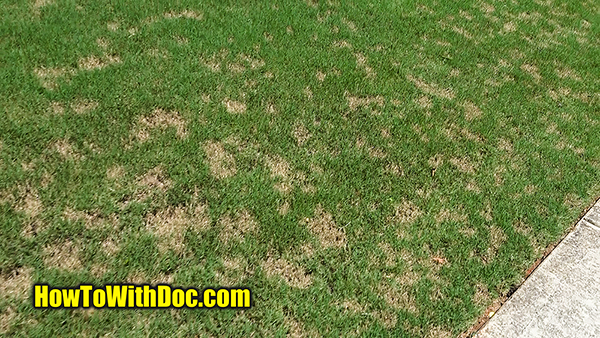
Brown patch below.

Grub damage – NOT a fungus below (see grub section)

To both prevent and cure the fungus apply the P-DG at the rate on the bag listed. You may treat up to 3 times. Then you must switch to a different chemical as the fungus will develop a resistance to the one product. After using the P-DG, switch over to the BIO-ADVANCED spray product we list.
Yellow Blades of Grass
We said YELLOW… not brown. In general yellow blades are from chlorosis Yellow blades generally lack key nutrients such as iron and nitrogen. Such deficiencies cause your grass to experience growth problems, including chlorosis, a condition that occurs when the green chlorophyll in the grass leaf tissue doesn’t develop.
Three things GENERALLY cause this.
- Over watering
- High phosphorus levels.
- PH imbalance.
The quick fix is to spray the lawn with Super Juice and add a little extra liquid iron. In the meantime… get a soil test done. However there is a REASON for the yellowing blades and you should work on figuring it out. Is the PH too high which locks up the iron? Are you watering too often? Have you been using a fertilizer like Miloganite which is high in phosphorous?
Red / Purple Blades of Grass
Red / purple tips are generally caused by two issues.
- Stress / cold damage. Goes away in a few weeks.
- Lack of phosphorus – Apply a little 10-10-10
Not a big deal and usually seen in the spring when a stray cold front comes through. I see this every spring in my lawn and it simply goes away with warmer weather. COLD STRESS… is the main cause.
Grubs and Grub Damage

Grubs do not feed at the surface. They stay in the ground and feed on roots. Three main signs you have grub damage. Brown dying patches that can be pulled up easy. (See video) Crows constantly on your lawn eating grubs. Armadillos or skunks digging up the ground and eating the grubs.
Dig up the sod / ground and fold it back. You will generally see grubs at 2-6” deep.
When to treat for grubs? Generally… in the spring and then late summer / early fall. That is when grubs look like grubs, white chubby worms, and be killed with the right product.
What to kill them with? Only one product we recommend, Dou-Kill product HERE
DO NOT use any other product as it may not kill the grubs. (Even if the bag says it does.) Apply at the HEAVY rate and then water, water, water, it into the ground. It must reach the grubs. Once the grubs are killed apply PGF Complete and the lawn should heal up in about 6 weeks.
Personally… I recommend people do at least one grub treatment a year in my area. We have seen so much damage from them it’s bound to show up.
Fall Army Worms
Yes… You’ll Probably get Them
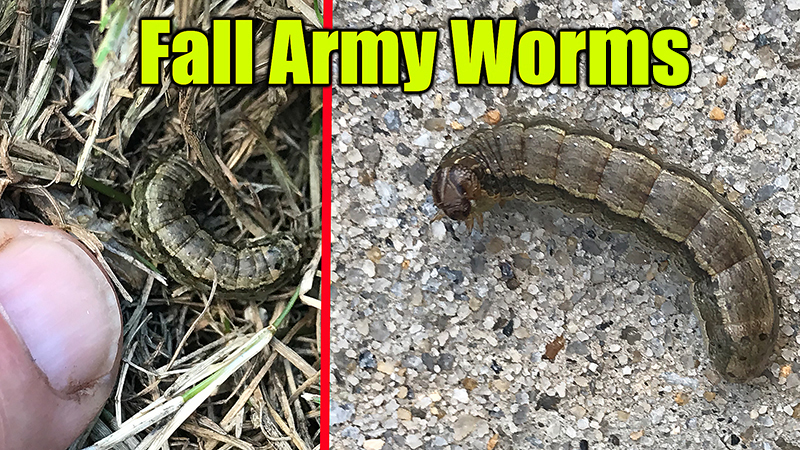
Unlike grubs that live SUB-surface, armyworms live and eat above the soil. They hide in the thatch layer and in the morning and early evenings come out to feed. They feed on the actual BLADES of you grass, not the roots. So the damage is more VISUAL… than the physical damage done by root eating grubs.
Armyworm eggs are laid by moths, so if your neighbor has them, you’ll get them. They vary each year but some years can be bad and they work across your lawn like an ARMY… eating the grass and causing it to look thinned out. In Georgia we generally have to battle them early August – September and it may take two treatments due to the egg hatch cycle.
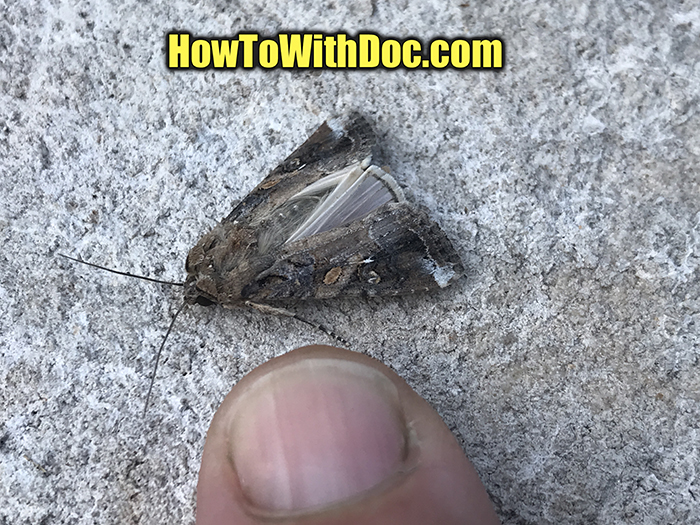
Watch the video below to learn how to detect them and treat them.
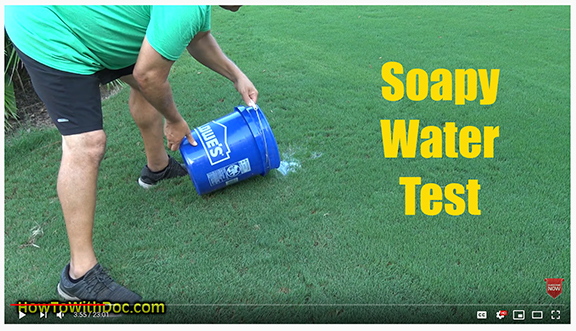
Aeration of Bermuda Grass
Most people that aerate their Bermuda lawn do so in the late spring. Aeration should be done with a CORE PULLING aerator, not a spike unit. Many say leave the cores on the lawn, we don’t. We feel they cause more of a mess and cover up the grass from sun, more than they might return any nutritional value. Watch the video below to better understand.
Aeration should be done during the ACTIVE growing season. So anytime from spring to early summer is best.
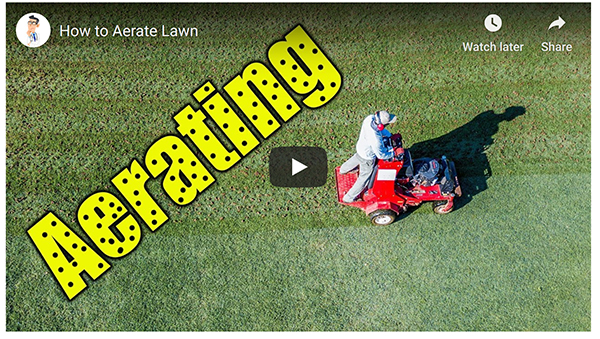
Special Note… this is a GREAT time to also put down a HEAVY treatment of HUMICAR™. Some of the carbon will work into the deep holes and you can use a blower to FORCE the particles into the holes. Remember, we never till a lawn.
Will Aeration Ruin My Pre-Emergent Treatments?
No… studies and most AG specialists agree that little to no impact on the effectiveness of the PE treatment after aeration. The % of ground being opened up is VERY small and the holes are very deep. We have also never had any issues.
Late Winter / Early Spring
KICK START (NEW)
The past few years we experimented with a new program that REALLY helped our Bermuda grass establish quickly and spread. This is your goal FYI. Get it going fast, make it thick, and everything else is pretty easy.
The FOCUS point of this starter program is the WAKE UP period and allowing your Bermuda to wake up into an amazingly healthy environment. In other words… don’t try and play catch up. Get SOME of the nutrients it needs into the soil BEFORE it wakes up.
NOTE: We are NOT saying PUSH your lawn early with high levels of nitrogen. That is not a good idea. We simply want to ensure that all the needed nutrients and microbes are in the root zones as the plant comes out of dormancy. Remember… your soil has been sitting dormant too being washed and washed by all the winter rains and snows. This depletes nutrients, organic matter, and microbial activity zones.
Step #1
Get a soil test done early (winter). However, 90% of you WON’T do this step. So just move onto step #2. The soil test will tell you if your lawn is deficient in any nutrients and you can apply a fertilizer to correct. Often, the extension office will simply tell you to apply 10-10-10 anyways. This also tells you what your PH is like. Bermuda grass likes to be around a 6.0 ph.
Step #2
Around the time you put out your EARLY granular pre-emergent, also apply a treatment of HUMICHAR™ and a treatment of 10-10-10 PGF Balanced . Then apply the HUMICHAR™ at the bag rate.
What will this do?
- The pre-emergent will stop weeds before they emerge.
- The HUMICHAR will improve your soil health, add carbon, and increase the CEC.
- The 10-10-10 will quickly release into the soil and fill it with nutrients without… a strong nitrogen push.
Again… this is done EARLY… when SOIL TEMPS are hitting about 50 degrees. For us in GA this is usually around late Feb / early March. Yes, your Bermuda grass will still be dormant.
Think of it like a programmable thermostat.
It’s winter, and it’s cold. You get out of bed, run to the thermostat, turn on the heat, jump back into bed, and wait for the room to get warm.
Now imagine having a programmable thermostat that turned the heat on 30 min before you woke up. You get out of bed into a comfortable environment.
Step #3
Kill any existing weeds. NOW…. Is the time to kill off any weeds that are growing. Weed killer is a NEGATIVE and best applied while your grass is still asleep. Use a Bermuda safe weed killer spray on the website. Do NOT use something like Round Up grass and weed killer. It’s a MYTH that this is safe to use during dormancy as most lawns are never 100% dormant. You will KILL the grass that is awake.
***Do not now the grass after this treatment until you have had a rain, or have irrigated the lawn.
Pre-emergent Late Winter / Early Spring
This is a CRITICAL step in your lawn program…. Get it right.
“Pre-Emergent is God’s gift to Bermuda lawn owners.” Doc
Pre-emergents (PEs) don’t really stop seed germination. The slow / stop the formation of new cell growth with what they contact. Since they are in the soil… they CONTACT newly sprouted seeds and the roots. Stop the growth of roots and the new seedlings die off. That’s a simplified explanation but will put your mind in the right frame as to how they work. Hence… we don’t apply them to new sod. New sod has roots near the surface of the soil and the PE can come in contact with the roots limiting root growth.
Why are they critical?
With the exclusion of a few sprouts of nutsedge, which PEs don’t work on, in 2019 & 2020 I had ZERO… and I repeat… ZERO weed killers to my yard. That is a true statement. Therefore my lawn suffered no NEGATIVE sprays or treatments. This is due to the proper use of PEs.
I can’t stress enough just how important this step is in your lawn program.
Putting down PEs the way we show is a critical step in having a beautiful lawn. This includes…
Proper Application
Split the timing
Be a little early
Watch out for Poa Annua regrowth after scalping.
How to Properly Put Down Pre-Emergents
Every area / zone has a “target date” for the application of PEs. Generally this is when soil temps hit a constant level of about 51 – 53 degrees. In my area everyone says March 15th. This is when weed SEEDS such as crabgrass START to germinate.
OK… so March 15th is my target date and we know that PEs last 6 – 12 weeks. So… why not put down your first application a little before that date… just to be safe… and then another application just after that date? One being a long lasting granular and the second being a liquid that also has POST emergent killing properties on crab grass. Just in case we missed some.
I recently explained this method to a 40 year agronomist and his comment was… “That is elegant; I wish I had thought of that.”
It’s also important to understand that when we SCALP our lawns, we often stir up surface seeds for things such as poa annua. This SURFACE SEED bloom is taken care by our second spray treatment.
Both of the PEs are listed on the website and watch for the videos coming out soon.
Fall PE Treatment
I prefer to hold off on my fall PE treatments as long as possible. Many say to put them down in September, but I hold off until the first COLD weather moves in which is usually around Nov 15th. The only thing this treatment does is prevent winter weeds such as poa annua. It will NOT prevent spring weeds. To me, this treatment is NOT a big deal unless you had LOTS of winter weeds the year before. Use the granular shown on the website.
Spring Scalping Bermuda Lawns
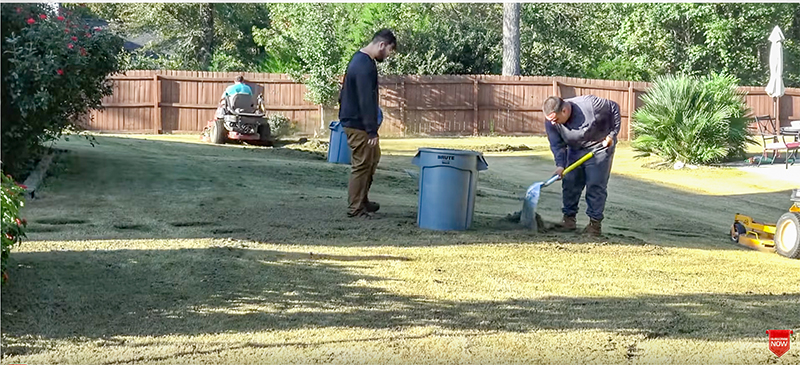 The spring scalp of Bermuda lawns is a critical step if you want a GREAT looking lawn. Why do we need to scalp? Coming into spring all the TALL Bermuda above the soil will be brown and dead. Let’s say you let it grow to 2.5” in the fall. So now you have 2.5” of brown grass. If you want to have a solid GREEN lawn that is 1” tall… who is going to see it? … NOBODY.
The spring scalp of Bermuda lawns is a critical step if you want a GREAT looking lawn. Why do we need to scalp? Coming into spring all the TALL Bermuda above the soil will be brown and dead. Let’s say you let it grow to 2.5” in the fall. So now you have 2.5” of brown grass. If you want to have a solid GREEN lawn that is 1” tall… who is going to see it? … NOBODY.
The dead brown Bermuda grass needs to cut very low, hence the term SCALPING.
You should scalp your Bermuda lawn to roughly 50% of the height you want your lawn to be during the normal growing season. So, if you want your green Bermuda lawn to be 1.5” you should scalp your dead lawn down to ¾” Make sense?
LEAVING YOUR BROWN GRASS HIGHER WILL GIVE YOU AN UGLY YARD….. YOU NEED TO TAKE IT LOWER THAN THE GREEN IN THE SPRING.
When to scalp?
Normally I scalp my lawn when I start to see a TOTAL “green haze” all over my lawn and daily temps are constantly reaching the 70s. (Late March – early April here in GA) I do dread the scalp as it is a huge task because the massive amount of dead clippings need to be bagged and removed. (Watch the scalp video)
We do I pay a crew?
Scalping is HARD on equipment. In fact, one lawn service told me they wouldn’t come back and do it next year because it was simply too hard on their equipment. I had no issues with that. I agree. One thing you can do is scalp little by little over a period of 4-6 weeks rather than do it all in one day which is a bit over whelming.
Watering Your Bermuda Lawn
The “general” rule of thumb is that Bermuda turf likes one inch of water per week. The second rule is that it’s better to water deep and heavy rather than lots of short waterings. This is true under normal growing conditions. Follow these two rules most of the time. Remember too that constantly wet soil and over watering may cause a bit of chlorosis.
However, if you have a drought move in… i.e. no rain for 3 weeks and temps in the 90s, you may have to use my short cycle program. Video below
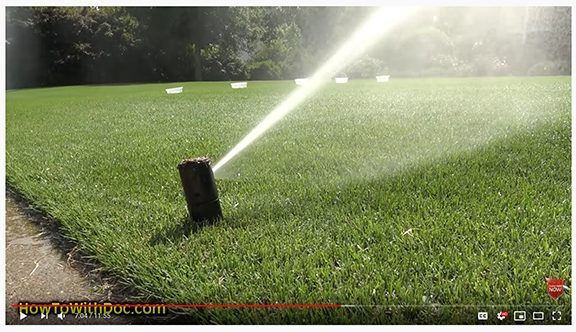
The problem with trying to follow the DEEP watering rule is that you, like me, probably have areas that dry out very quickly. These are known as HOTSPOTS. These hotspots come from underground formations and conditions such as construction debris, tree roots, septic drain areas, sand zones, etc.
The only way to keep these areas from browning out is to apply light waterings every morning and late afternoon. I run my zones for about 6-9 minutes per zone per watering during these extreme drought conditions. For the most part… this light watering will keep all my lawn green. Play with it and just keep an eye on your water usage. Droughts can be expensive.
Killing Weeds
PRODUCT NOTE: Please visit the → WEED KILLING SECTION of the website to look at the best current products.
VIDEO NOTE: There are TONS of weed killing videos and pages on the website.
There are 4 basic groups of weeds in “MY WORLD”.
- Broadleaf weeds (easy kill)
- Grassy weeds (easy kill)
- Crabgrass (med kill)
- Nutsedge (med kill)
- Dallis Grass / Goosegrass (VERY HARD KILL)
Most of the above can be and should be controlled with GOOD and HEAVY pre-emergent treatments. Often dallisgrass and goosegrass, very tough to kill, will germinate later and therefore our split PE application really helps. Dallis grass and goosegrass are the hardest to kill and often I spot treat with a tiny cloth and RoundUp type killer, applying ONLY to the plant itself. Labor intensive I know but saves the Bermuda.
I really don’t have to kill weeds on my lawn anymore. This is because I STRICTLY follow a good pre-emergent program. Yes… I said zero weeds. The only thing I have is a little touch of nutsedge now and then since PEs don’t control them.
Couple of “rules”…
In the winter watch the forecast and wait for a WARM spell of weather. Weed killers do not work well in freezing temps. Wait for a few days of temps rising up and treat. Watch video below
In the summer heat or during drought conditions, use caution and read labels. Often weed killers will temporarily yellow out or brown our Bermuda grass.
Make sure you understand which products kill via leave surface coverage vs. those that kill via being watered in and killing via the roots.
Yard full of weeds?
If your yard looks like “hell”… full of weeds and little Bermuda grass… then watch the CURTAIN OF DEATH video below. Basically we apply a mix of all weed killers and pre-emergent during the warmer / hotter months. This will also brown out your Bermuda grass as well but not kill it. Then we fertilize and water, water, water… and nothing comes back but the Bermuda.
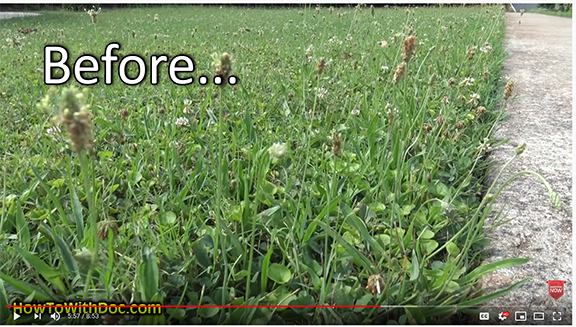
In the video above you’ll see the transition.
Still having WEED PROBLEMS? I suggest you look into another treatment of pre-emergent if you are still battling weeds. Once you have watered that in, go ahead and kill of the rest of the weeds. You should be good from that point on.
Your Soil Sucks… Adding Organic Matter
Soil microbes are GOOD… mycorrhizal fungi in soils are GREAT for lawns. Both play critical roles in the health of your lawn. However, both need quality ORGANIC matter to survive. This is why we created DIRT BOOSTER.
DirtBooster can be applied to your lawn in a spreader, then spray it with the microbe and fungus booster pack which is included. Do this when temps are warmer, above 80 degrees, and do this as often as you want.
